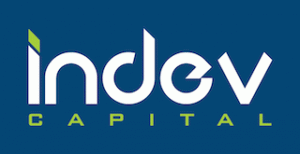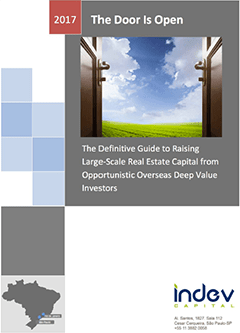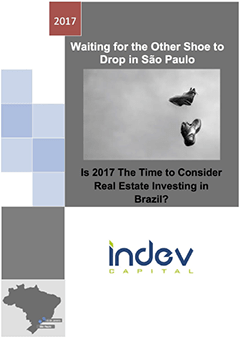
Opportunity
Some of the best investment strategies often rely on thinking differently or uncovering value that other investors do not see. Often this ability to understand and capture value early leads to selling to the “latecomer” investors at a premium when the strategy becomes obvious. In today’s Brazil’s distressed environment, an ability to identify pockets of value that others do not see can potentially generate significant risk-adjusted returns.
Objective
This newsletter will provide a background on the unique investment opportunity of the commercial floor sector in Sao Paulo. The document will provide a perspective on the commercial floor market, the sector’s relevance for Institutional Investors, stabilized cap rates that are available , liquidity options, and potential IRR returns. As always, if an investor has more detailed or specific questions, please email to joseph.williams@indevcapital.com and our team at InDev Capital will be glad to help.
Financing of Commercial Property
Credit for real estate development in Brazil, relative to the United States, is limited. In the USA and other developed economies, banks finance the construction of for rent commercial and residential multi-family buildings. Once the building is stabilized, long-term loans are available based on the performance of a stabilized cash flow generating project. Currently, this type of long-term financing option is not available in Brazil.
Brazil’s Market Adaptation
Sao Paulo-based real estate developers, due to the lack of construction finance for commercial for rent projects, pre-sell entire floors of a building to wealthy families. This capital is used to finance construction. A very well-developed ecosystem of investors and developers exists for this commercial floor market segment. Commercial development by developers in Sao Paulo (investors that invest before construction) is almost always a “friends and family” type of investment opportunity for wealthy families in Sao Paulo.
At the end of construction, a developer maintains ownership of a certain percentage of the floors, usually at least 20% to 30%, and the remaining floors go to individual investors (not too different than in the picture above). Sometimes these investors purchase multiple floors depending on the project and the wealth level of the investor. Importantly, these investors are wealthier, more sophisticated, and possess a much longer time horizon of the investment than for sale “condo apartment” investors.
Strata Title Explained – Developed Market with Rules of the Game
As the building has multiple owners upon completion, it raises many questions that an investor must understand.
1) How does the management of the property work and who is in charge of the building?
Similar to many single-owner commercial buildings, “A Large Property Manager” is often hired to manage the building.
2) How does an investor prevent another floor owner from offering a “low ball” rental rate, which likely reduces potential rents for other floor owners and thereby destroys value?
Owners are rational market players and work to protect value. However, it is critical to not overpay, analyze the market, and understand market comparables. It is also important to maintain and/or improve a property relative to its comparable product in the same building and in the general market area.
3) What improvements can be made by the floor owner with no consideration of other owners?
In most cases, all changes can be made with the exception of the facade and the elevator.
4) Is there any right of first offer provision by other owners that want to buy additional floors in a building to gain control when a floor is for sale?
Usually the best buyers are those that own current floors, normally traded among insiders. Currently, this is a unique opportunity as there is not a liquid market locally. However, there is no legal right of first offer or first refusal.
Liquidity
Counterintuitively, the commercial floor market is more liquid than large commercial buildings in Sao Paulo. Why? There is no formal debt market to finance an acquisition of a stabilized commercial building in Sao Paulo. With no debt, these purchases become an equity which radically reduces the number of buyers.
However, for commercial floors there is a well-developed ecosystem of individual investors, developers, family offices, and even small Real Estate Investment Trusts that invest in the commercial floor market.
As the purchase price of commercial floors is lower, the universe of buyers greatly expands. Commercial floor buyers are prepared to pay in 100% cash, which is always an easier and faster transaction.
Almost without exception, wealthy families in Sao Paulo have commercial floors as a significant part of their Investment Portfolio. Why? Commercial floors, in all except the very worst of times, are a store of value that can generate attractive yields. In addition, due to the large number of investors able to purchase a commercial floor(s), it is a relatively easy asset to turn into cash (except right now which is the opportunity!!!!!).
Finally, unlike public equities that may not generate income, commercial floors have current yield. For a foreign investor, this current yield of a leased commercial floor (rents are adjusted with a pricing/ inflation index) can serve as a hedge against inflation and currency adjustments.
A Perfect Storm Creates an Opportunity
Many wealthy families in Brazil (and most of the world) generated their wealth through the ownership of small and medium-sized companies. During Brazil’s recent economic expansion, the cost of capital (SELIC) reached as low as 7.5%.
At that time, many of Brazil’s small to medium businesses accessed the credit market. Economic expansion and business confidence created an environment where many of these companies financed core growth investments with bank borrowings. Given the lack of long-term finance in Brazil, many of these bank borrowings were in the form of working capital lines with interest rates tied to the Brazil standard interest rate.
Brazil’s SELIC interest rate has increased from 7.5% to 14.25% over the past three years, which has increased the cost of borrowing for any of these small to medium-sized companies to 20% or more per year. Ouch!
The Trade and How to Cut a Deal
Current costs on corporate credit lines are up to 20%+ per year. A 20% interest rate is very expensive for any business, particularly if the debt has a large balance. Therefore, these families are now selling commercial floors at a price that simply would not occur in a normal environment. The math of the trade follows.
For example, a family has an operating business in the oil services center. The family company has a $50M debt principal balance (which is increasing) with an interest rate of 20%. Interest costs alone are $10M per year and growing. Sales are slow therefore the company cannot pay the full interest payment. The family is actually “coming out of pocket” and having to invest real cash every month to keep the company going through this tough time.
However, the same family has a portfolio of commercial floors that generates $6M a year in income. This portfolio cannot cover their total interest payment (nor can the operating company.) Nonetheless, if the family sells the portfolio at a 12% cap rate, they can reduce their debt to zero ($6,000,000 / 12%=$50,000,000).
This unique and powerful investor negotiating position stated above will not last forever. However, with the right local partner, proper execution, the right strategy and local contacts, InDev believes that an investor can accumulate a very attractive portfolio with very attractive cap rates.
Upside – Over Time Brazil Improves
It is likely that the next government will be able to stabilize government debt spending and reduce the debt to GDP ratio. This move, when it occurs, will provide a window for Brazil’s central bank to begin to lower interest rates.
Currently, a lot of wealthy families are invested heavily in fixed income investments tied to the government SELIC interest rate. Why? The high yields offered by the government are attractive.
However, as interest rates go down fixed-income investments will lose their attractiveness. It is likely that the first investment strategy these wealthy families choose is a return to commercial floors.
In fact when interest rates are lower, the Brazil REIT market opens up again. Unlike the USA, Brazil’s REITs purchase not only buildings but commercial floors as well. The potential cap rate compression that an investor could potentially enjoy over the next several years in Brazil is significant.
Investment Thesis
No Development Risk
Commercial Floors are existing assets with positive cash flow. For many investors, taking development risk at this time in Brazil does not make sense. This strategy is based on taking advantage of distress to purchase existing assets with the potential to generate immediate cash.
Non Negative Carry – With Significant Upside
Through carefully building a portfolio of assets, an investor can build positive cash flow while at the same time taking advantage of unique vacancy purchase opportunities.
For example, an investor can purchase three floors with tenants and cash yields of 12%+ and purchase one vacant floor at a significant discount. In the future, at even below market rents the vacant floor could provide a yield on costs of 14%+ based on an excellent purchase.
This purchase of cash flow while opportunistically looking at vacancy provides an opportunity to boost returns significantly.
Limited Downside
The first step to making money is to make sure one does not lose money. Based on buying existing assets with cash flow in specific attractive locations, the downside is limited.
Zoning Creates Value
InDev Capital has written extensively about zoning and how it creates value in Sao Paulo. Please find our newsletter about zoning by (clicking here). In summary, the zoning laws of Sao Paulo create significant barriers to entry for new buildings of similar quality to the assets that an investor will purchase pursuing a commercial floor strategy.
The net effect of zoning is that an investor is not only buying below the replacement costs of the building or floor purchased, but the replacement costs for new development are even higher based on zoning restrictions. Please see a full description of zoning by (clicking here).
Why Now?
This strategy only works at this specific time in the real estate cycle. It requires the wealthiest families in Brazil (Sao Paulo is where most of them reside) to need to sell assets at distressed prices.
This opportunity exists today due to the high cost of capital in Brazil, AND the fact that many of the operating companies, the source of wealth for many of these families, must reduce their debt load immediately.
As the interest rate environment improves, some macroeconomic expansion occurs, or even a stabilization of GDP in Brazil comes about, these commercial floor assets will no longer be for sale and these families will hold on.
Therefore, it is extremely important for an investor that desires to generate maximum returns to start looking at this strategy now. We believe that the best time to be a buyer is over the next six to twelve months.
Importantly, the race is not to purchase before the complete turnaround of Brazil’s economy but to purchase and build a portfolio of assets before the complete turnaround in the psychology of the owners of these assets. This likely occurs before the complete economic turnaround.
Next Steps
InDev Capital will be in North America in the next thirty days with a Brazilian sponsor executing this strategy that seeks a JV partner for $50M to $75M. The goal is to build a top-tier portfolio of commercial assets through the execution of this unique strategy at this time in the real estate cycle in Brazil.
If interested in discussing this unique strategy, please let me know at joseph.williams@indevcapital.com

Joseph W. Williams
CEO & Founder InDev Capital




